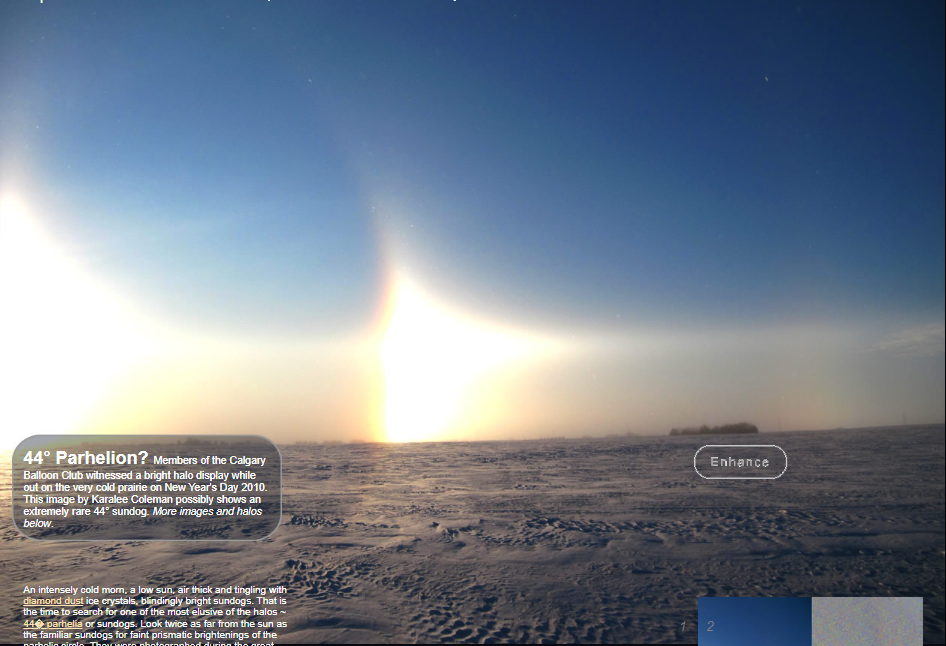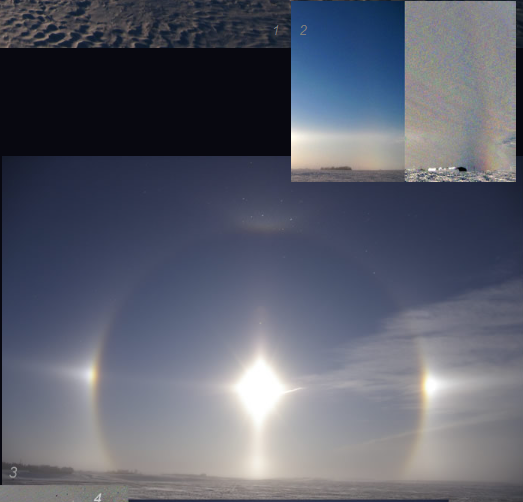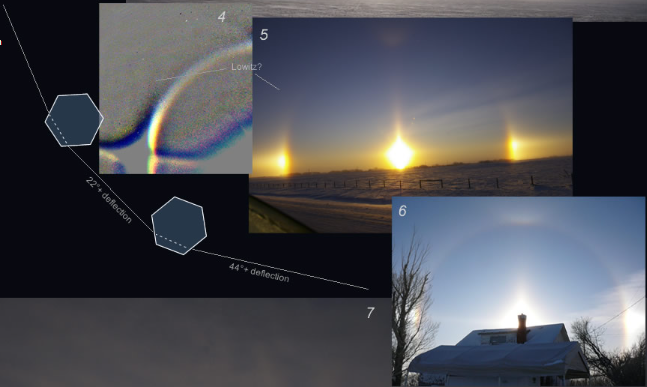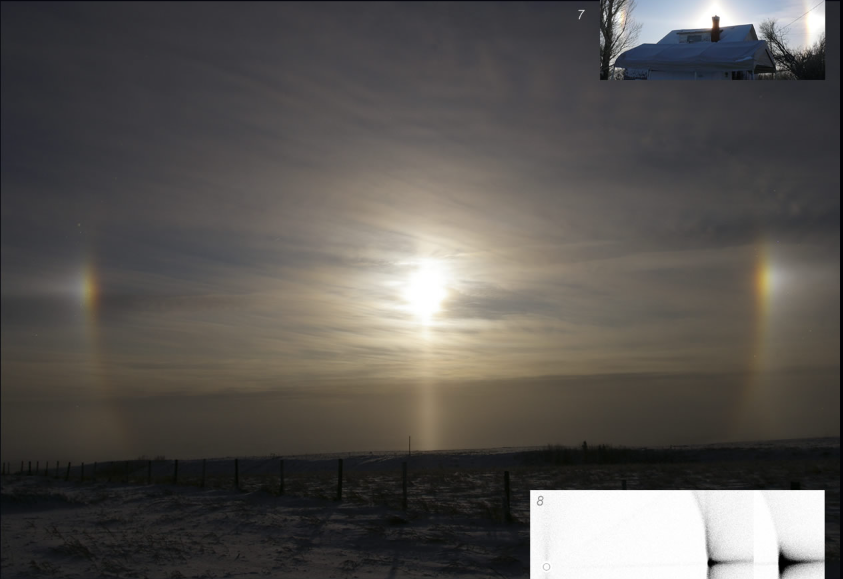OPOD - Balloon Meet Halo Display
OPOD - Balloon Meet Halo Display: Exploring the Elusive 44° Parhelion
On New Year's Day in 2010, members of the Calgary Balloon Club were treated to a spectacular display of atmospheric optics. As they braved the intensely cold prairie, they witnessed a mesmerizing halo display that included an extremely rare phenomenon known as a 44° sundog. This breathtaking event was captured in an image by Karalee Coleman, showcasing the beauty and wonder of nature's optical illusions.
The Quest for 44° Parhelia
During the early morning hours of that fateful day, with the sun hanging low on the horizon, the air was thick with diamond dust ice crystals. These tiny ice particles created a dazzling effect, causing sundogs to appear in all their glory. Sundogs are commonly observed optical phenomena, but the elusive 44° parhelia are a rare sight indeed. To spot them, one must look twice as far from the sun as the familiar sundogs and search for faint prismatic brightenings along the parhelic circle.
Distinguishing the 44° Parhelia
Identifying the 44° parhelia poses a challenge even for seasoned observers. These elusive halos can be easily mistaken for the more common 46° halo, which crosses the parhelic circle just two degrees further from the sun. The presence of diamond dust swarms near the horizon can intensify the brightness of the 46° halo, making it resemble a sundog. Moreover, other optical phenomena, such as supralateral and infralateral arcs, also intersect the parhelic circle at approximately 46° from the sun.
To differentiate between the 44° parhelia and the similar-looking halos, accurate measurements are crucial. However, standard camera lenses often introduce distortions that hinder precise sun distance calculations. A more reliable approach involves estimating the position where the 46° halo intersects the parhelic circle and measuring the distance of the suspected parhelion from that point. This method assumes that the observer can confidently distinguish a 46° halo from a supralateral arc, which is no easy task.
Double Scattering and Bright 22° Sundogs
In most cases, halos are formed when sunlight encounters an ice crystal only once. However, the 44° parhelia are an exception to this rule. Some rays of sunlight, after being deviated by a plate crystal, encounter another plate and experience further deviation. This double scattering phenomenon requires dense plate crystal swarms, which also produce exceptionally bright 22° sundogs. These sundogs, branching out from the intensely bright 22° halos, add to the ethereal beauty of the atmospheric display.
Uncertainty Surrounding Identification
While analyzing the images captured during the balloon meet halo display, uncertainty arises when attempting to identify the 44° parhelia. The regions of intense coloration at what should be the altitude of the sun in some images could simply be intense segments of the 46° halo or infralateral arcs. Consequently, confirming the presence of the elusive 44° parhelia becomes a challenging task, leaving room for doubt and speculation.
Unraveling Lowitz Arcs
The balloon meet halo display had more to offer than just the elusive 44° parhelia. Observers also noticed traces of rare Lowitz arcs branching upwards and outwards from the bright 22° sundogs. These fascinating arcs, captured in images (3), (4), and (5), added an extra layer of intrigue to the spectacle. Image (7) presents an intriguing possibility: it might show Lowitz arc "pillars" extending downwards from the sundogs. However, it is important to note that the wobbling of plate crystals, deviating from horizontal by approximately 3-4°, can also create a similar pillar-like effect.
The Beauty of Nature's Optical Illusions
The balloon meet halo display of New Year's Day 2010 was a true testament to the wonders of atmospheric optics. Nature's ability to create intricate and elusive phenomena, such as the 44° parhelia and Lowitz arcs, continues to captivate and inspire. Thanks to the dedicated efforts of photographers like Karalee Coleman, Ralph Dowson, and Colin Hamlyn, these ephemeral moments are preserved for us to marvel at and study.
Conclusion
The balloon meet halo display served as a reminder of the incredible beauty that lies hidden within the atmosphere. The rare sighting of the 44° parhelia, the challenge of distinguishing it from other halos, and the presence of intriguing Lowitz arcs all added to the enchantment of the event. Atmospheric optics continues to be a field of exploration and discovery, showcasing the remarkable complexity and elegance of our natural world.

44° Parhelion? Members of the Calgary Balloon Club witnessed a bright halo display while out on the very cold prairie on New Year's Day 2010. This image by Karalee Coleman possibly shows an extremely rare 44° sundog. More images and halos below.



An intensely cold morn, a low sun, air thick and tingling with diamond dust ice crystals, blindingly bright sundogs. That is the time to search for one of the most elusive of the halos ~ 44� parhelia or sundogs. Look twice as far from the sun as the familiar sundogs for faint prismatic brightenings of the parhelic circle. They were photographed during the great Saskatoon display of 1970 and next in January 2004 in Minnesota.
The challenge is to distinguish them with any certainty from the 46� halo which crosses the parhelic circle just two degrees further from the sun. Diamond dust swarms can hug the horizon and brighten the 46� halo there to make it appear like a sundog. Supralateral and infralateral arcs also cross the parhelic circle at 46�+ from the sun.
Camera lenses have too many distortions to allow the sun distance to be accurately measured unless they are individually and laboriously calibrated on a star field. A safer way is to measure the distance of the suspect parhelion from an estimate of where the 46� halo would cross the parhelic circle. Of course, that requires a 46� halo distinguished with certitude from a supralateral arc!
Most halos are formed by sun rays that have encountered an ice crystal only once. 44� parhelia are the exception. Some rays deviated by a plate crystal encounter a second plate and are deviated further. Double scattering requires very dense plate crystal swarms and these also produce very bright 22� sundogs.
The topmost image (1) when enhanced (mouse over the button) shows colours at and below the parhelic circle apparently sunwards of the faint 46� halo. Image (2) is a similar enhancement. Was the upper halo a 46� or supralateral? Images (3), (5) and (6) have only a weak upper tangent arc suggesting a low concentration of horizontal column crystals and therefore only a weak or nonexistent supralateral arc.
Other images leftwards of the sun show a second possible 44� parhelion. However, both the '44°' coloured regions are brightest below the altitude of the sun and could be merely intense segments of the 46� halo or infralateral arcs. The 44� parhelion identification is unfortunately rather uncertain.
More was going on. Branching upwards and outwards from the intensely bright 22� sundogs there are traces of rare Lowitz arcs � images (3) (4) and (5). Image (7) is intriguing. It might show Lowitz arc �pillars� extending downwards from the sundogs. On the other hand, plate crystals wobbling 3-4� (std dev.) from horizontal also produce a pillar like effect as in the HaloSim ray tracing comparison (8).
Photos (all copyright the photographer):
Karalee Coleman - (1),(2)
Ralph Dowson - (6)
Colin Hamlyn - (3),(5),(7)
Hearty thanks to Alan Clark of University of Calgary for collecting the images and his analysis.
Note: this article has been automatically converted from the old site and may not appear as intended. You can find the original article here.
Reference Atmospheric Optics
If you use any of the definitions, information, or data presented on Atmospheric Optics, please copy the link or reference below to properly credit us as the reference source. Thank you!
-
<a href="https://atoptics.co.uk/blog/opod-balloon-meet-halo-display/">OPOD - Balloon Meet Halo Display</a>
-
"OPOD - Balloon Meet Halo Display". Atmospheric Optics. Accessed on November 26, 2024. https://atoptics.co.uk/blog/opod-balloon-meet-halo-display/.
-
"OPOD - Balloon Meet Halo Display". Atmospheric Optics, https://atoptics.co.uk/blog/opod-balloon-meet-halo-display/. Accessed 26 November, 2024
-
OPOD - Balloon Meet Halo Display. Atmospheric Optics. Retrieved from https://atoptics.co.uk/blog/opod-balloon-meet-halo-display/.